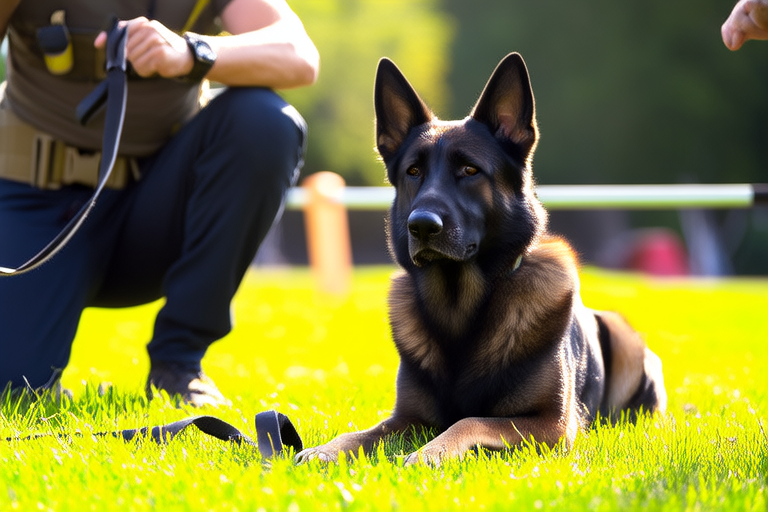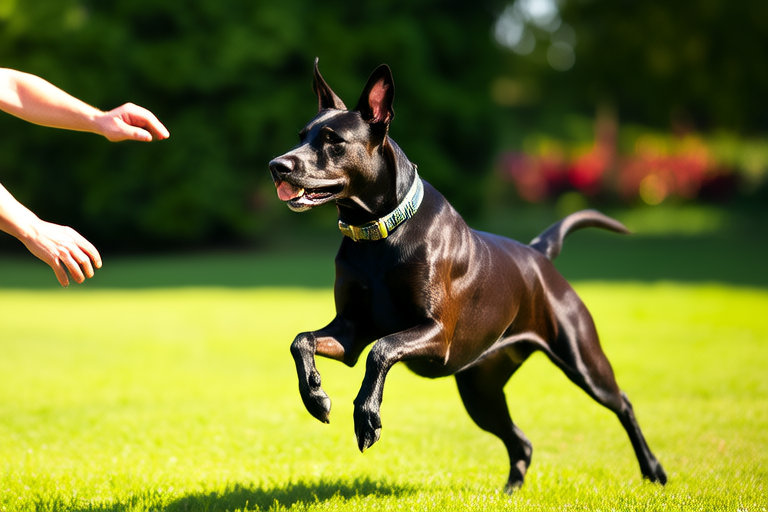
Ultimate Guide: Training Your German Shepherd Like a Pro
Welcome to the Ultimate Guide to Training Your German Shepherd Like a Pro! Whether you’re a first-time owner or have years of experience, this guide will provide you with the knowledge and tools necessary to train your German Shepherd effectively. From understanding their unique behavior and intelligence to advanced training techniques and maintaining consistency, we’ve got you covered.
Understanding German Shepherds’ Behavior and Intelligence
German Shepherds are renowned for their loyalty, intelligence, and versatility. They are highly trainable dogs that excel in various roles such as police work, search and rescue, and therapy. Understanding their behavior and intelligence is crucial to establishing a strong bond and effective communication between you and your dog.
German Shepherds are pack animals by nature, which means they naturally look for a leader in their environment. As their owner, it’s your responsibility to establish yourself as the alpha figure in the pack. This leadership role requires patience, consistency, and a firm but gentle approach. By setting clear boundaries and rules, you can ensure that your German Shepherd respects and listens to you.
One of the most important aspects of understanding your German Shepherd is recognizing their body language. Dogs communicate primarily through body signals, and learning to read these signals can help you better understand your dog’s emotions and intentions. For example, a wagging tail can indicate happiness or excitement, while a lowered tail may suggest fear or submission. Paying attention to your dog’s posture, ear position, and eye contact can also give you valuable insights into their state of mind.
Essential Basic Training Commands
Training your German Shepherd starts with mastering essential basic commands. These commands form the foundation of your dog’s obedience and will make daily life easier for both you and your pet. Here are some of the most important commands:
- Sit: This command teaches your dog to remain stationary in a seated position. It’s useful for preventing jumping and maintaining control in various situations. To teach your dog to sit, hold a treat above their head and say “sit.” As your dog looks up, their bottom should naturally lower. Once they sit, reward them with the treat and praise.
- Stay: The stay command helps your dog remain in place even when distractions are present. Begin by having your dog sit, then extend your hand palm out and say “stay.” Take a few steps back and return to your dog. If they remain in place, reward them with a treat and praise.
- Down: Teaching your dog to lie down can be beneficial for calming them down and ensuring they remain still. Start with your dog sitting, hold a treat near their nose, and slowly move your hand down towards the ground. As your dog follows the treat with their nose, their body will naturally lower into a lying position. Reward them once they’re fully down.
- Heel: This command ensures your dog walks beside you without pulling on the leash. Use a leash to gently guide your dog into the desired position, and reward them for staying close to your side.
- Leave it: This command prevents your dog from grabbing items they shouldn’t. Place a treat in your closed fist and let your dog sniff it. When they try to take it, say “leave it” and wait until they stop trying. Once they’ve given up, open your hand and let them have the treat. Repeat this process several times, gradually increasing the difficulty by adding distractions.
Advanced Training Techniques
Once your German Shepherd has mastered the basics, you can move on to more advanced training techniques. These techniques can further enhance your dog’s obedience and prepare them for specialized tasks or competitions.
- Target Training: Teach your dog to touch a target (such as a stick or a specific object) with their nose. This can be used for guiding your dog through agility courses or teaching them to perform tricks. Hold the target in front of your dog’s nose and say “touch.” When they touch the target, reward them with a treat. Gradually increase the distance between you and the target, rewarding your dog each time they successfully touch it.
- Recall: A reliable recall command is crucial for ensuring your dog comes back to you when called, especially in potentially dangerous situations. Start by calling your dog’s name followed by “come” in an enthusiastic voice. When they come to you, reward them with treats and praise. Practice this in different environments and gradually introduce distractions to strengthen their response.
- Impulse Control: Teaching your dog impulse control can prevent unwanted behaviors such as jumping or barking excessively. One effective method is the “wait” command, where you instruct your dog to wait before they can eat or go outside. Place food in front of your dog and say “wait.” Once they’ve remained calm for a short period, release them with the command “okay” and allow them to eat.
The Importance of Socialization
Proper socialization is vital for raising a well-adjusted and confident German Shepherd. Exposing your dog to various people, animals, and environments from an early age helps them develop positive associations and reduces the likelihood of fear-based aggression or anxiety.
Start socializing your puppy at around 3 months old and continue throughout their first year. Introduce your dog to different environments such as parks, beaches, and busy streets. Encourage interactions with other dogs and people of all ages and backgrounds. Always supervise these encounters to ensure safety and maintain positive experiences.
During socialization, it’s important to monitor your dog’s reactions and comfort levels. If your dog shows signs of discomfort or fear, remove them from the situation and try again another day. Positive reinforcement plays a key role in socialization; reward your dog for calm and friendly behavior around others.
Tips for Maintaining Consistency in Training
Maintaining consistency is crucial for successful training. Inconsistency can lead to confusion and undermine your efforts. Here are some tips to help you stay consistent:
- Establish Clear Rules: Define what behaviors are acceptable and what are not. Be consistent in enforcing these rules across all family members.
- Use Positive Reinforcement: Reward good behavior with treats, praise, or playtime. Avoid punishment-based methods, as they can create fear and mistrust.
- Practice Regularly: Set aside time each day for training sessions. Short, frequent sessions are more effective than long, infrequent ones.
- Be Patient: Every dog learns at their own pace. Stay patient and persistent, and celebrate small victories along the way.
Common Challenges Faced During Training and Their Solutions
Training your German Shepherd may come with its share of challenges. Here are some common issues and practical solutions:
- Biting: Puppies often bite as part of teething or play. Redirect their attention to appropriate chew toys and discourage biting on hands or clothing. If biting persists, use the “leave it” command to teach them what they can and cannot chew.
- Destructive Behavior: Destructive behavior can stem from boredom, anxiety, or lack of exercise. Provide plenty of mental and physical stimulation, and consider crate training to prevent access to off-limits areas.
- Potty Training Issues: Accidents inside the house can be frustrating. Establish a consistent potty schedule, take your dog outside frequently, and reward them for going in the right spot. Clean accidents thoroughly to avoid attracting your dog back to the same area.
Nutritional Advice for Optimal Training Performance
A healthy diet is essential for optimal training performance. Proper nutrition provides the energy and nutrients needed for physical activity and mental focus. Consult with your veterinarian to determine the best diet for your German Shepherd based on their age, weight, and activity level.
High-quality protein sources like chicken, beef, and fish are crucial for muscle development and repair. Carbohydrates from whole grains such as brown rice or sweet potatoes provide sustained energy. Fats, particularly those from fish oil, support brain function and coat health. Vitamins and minerals are also important for overall well-being.
Feeding your German Shepherd regular meals rather than free-feeding can help maintain a healthy weight and regulate their energy levels. Avoid feeding table scraps, as they can upset your dog’s digestive system and lead to unhealthy eating habits.
How to Keep Training Sessions Engaging and Fun
Making training sessions enjoyable for both you and your German Shepherd is key to keeping them motivated and interested. Incorporate games and activities that challenge your dog mentally and physically:
- Agility Courses: Set up an obstacle course in your backyard using cones, tunnels, and jumps. Encourage your dog to navigate the course while practicing commands like “over,” “under,” and “through.”
- Fetch: Play fetch with a variety of toys to keep your dog engaged and active. Rotate toys to prevent boredom and keep the game exciting.
- Hide and Seek: Hide treats around the house or yard and encourage your dog to find them. This game promotes problem-solving skills and strengthens the bond between you and your dog.
- Interactive Toys: Invest in puzzle toys that require your dog to solve problems to retrieve treats. These toys stimulate your dog’s mind and provide entertainment during downtime.
Remember, training is a journey, not a destination. With patience, consistency, and love, you can train your German Shepherd to be a well-behaved, obedient, and joyful companion.






